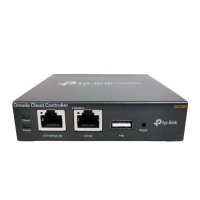
 Loading...
Loading...
Do you have a question about the TP-Link Omada OC200 and is the answer not in the manual?
| Networking standards | IEEE 802.3af, IEEE 802.3at |
|---|---|
| Ethernet LAN data rates | 10, 100 Mbit/s |
| USB 2.0 ports quantity | 1 |
| Ethernet LAN (RJ-45) ports | 2 |
| Input current | 1 A |
| DC input voltage | 5 V |
| Power over Ethernet (PoE) | Yes |
| Power consumption (typical) | 5 W |
| Flash memory | 4000 MB |
| Internal memory | 1024 MB |
| Processor frequency | 1000 MHz |
| Control display unit | No |
| Internal memory type | DDR3 |
| Management platform | L3 |
| Security algorithms | SSID, WEP, WPA, WPA-PSK, WPA2, WPA2-PSK |
| Certification | CE, FCC, RoHS |
| Product color | Black |
| Cables included | LAN (RJ-45) |
| Compatible operating systems | Windows10, 8, 7, Vista, XP; MAC OS; NetWare, UNIX; Linux |
| Storage temperature (T-T) | -40 - 70 °C |
| Operating temperature (T-T) | 0 - 40 °C |
| Storage relative humidity (H-H) | 5 - 90 % |
| Operating relative humidity (H-H) | 10 - 90 % |
| Package depth | 128 mm |
| Package width | 135 mm |
| Package height | 70 mm |
| Harmonized System (HS) code | 85176990 |
| Depth | 98 mm |
|---|---|
| Width | 99.8 mm |
| Height | 25 mm |